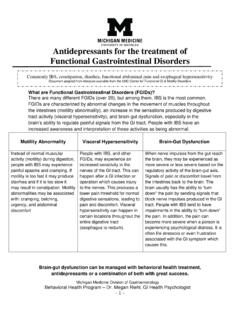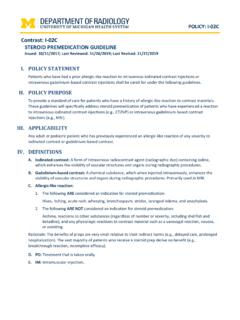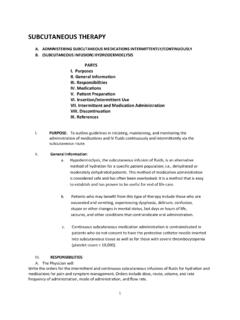Transcription of Michigan Medicine Ketamine IV Continuous Infusion ...
1 Michigan Medicine Ketamine IV Continuous Infusion Guidelines for Mechanically Ventilated Adult ICU Patients Background Ketamine is a N-methyl-D-aspartate receptor (NMDA) antagonist that creates a state of dissociative amnesia in patients. It is used frequently used for as an anesthetic for procedural sedation and in the operating room, as well as an induction agent rapid sequence intubation. Recent literature has suggested that Ketamine may be an effective sedative agent in mechanically ventilated patients. It has also has been studied in patients suffering from alcohol withdrawal, status asthmaticus, and status epilepticus. Pharmacokinetics Absorption: 100% IV absorption Distribution: 5-16 L/kg (increased in critically ill patients) Onset: Less than one minute Metabolism/Excretion: CYP3A4 and CYP2D6 mediated metabolism via N-demethylation and hydroxylation to norketamine and dehydronorketamine.
2 Norketamine is an active metabolite with ~33% potency of Ketamine ; dehydronorketamine is an inactive metabolite. Half-Life: Ketamine = 5-17 minutes, norketamine = 180-300 minutes Pharmacodynamics Ketamine primarily acts as an antagonist to the NMDA receptor, although it also has some antagonistic effects of delta, kappa, and mu receptors as well. Ketamine also inhibits re-uptake of catecholamines, which can yield an increase in blood pressure. Considerations ICU attending approval required for Continuous Infusion Ketamine use Ketamine should be used cautiously in patients with: Uncontrolled hypertension Pulmonary hypertension Moderate-severe hepatic dysfunction (Child-Pugh Class B and C) History of coronary artery disease Atrial arrhythmias Concomitant use of strong CYP3A4 and CYP2D6 inhibiting medications Patients with pre-existing history of schizophrenia or bipolar disorder Contraindications Allergy to Ketamine Active coronary ischemia Adverse Effects Hypertension Hyper salivation Transient respiratory depression Agitation Ketamine emergence reactions Management.
3 Hyper salivation may be managed via the administration of glycopyrrolate mg IV Q6H as needed. Emergence reactions may be managed with the administration of a benzodiazepine, either lorazepam 1-2 mg IV or midazolam 2-4 mg IV as needed. Hypertension is best managed by decreasing rate or stopping Ketamine Infusion ; no studies to date have described management of Ketamine -induced hypertension with antihypertensive agents. Indications and Dosing Sedation in adults who cannot tolerate other agents: Continuous Infusion of mg/kg/hr. Recommended initial rate is mg/kg/hr. Titrate by mg/kg/hr every 15 minutes to goal RASS. Status Asthmaticus: Optional bolus dose of mg/kg (max 50 mg) followed by Continuous Infusion of mg/kg/hr.
4 Recommended initial rate is mg/kg/hr. Titrate by mg/kg/hr every 15 minutes to clinical response. Alcohol Withdrawal: Optional bolus dose of mg/kg (max 30 mg) followed by Continuous Infusion of mg/kg/hr. Recommended initial rate is mg/kg/hr. Titrate by mg/kg/hr every 15 minutes to clinical response. Status Epilepticus: Optional mg/kg loading dose (150 mg max) followed by 1-10 mg/kg/hr Continuous Infusion . Starting rate and titration are at the discretion of ICU team only. Pain: Consult acute pain service for approval to use Ketamine for pain. Ketamine dose may titrated down to off quickly over the period of 60 minutes if necessary due to adverse events or for an awakening trial Dose Adjustments *Renal Dysfunction: Due to the primarily hepatic metabolism of Ketamine , dose does not need to be adjusted for renal dysfunction.
5 Ketamine has been administered to patients with ESRD without effects of dose accumulation noted. **Hepatic Dysfunction: To date, no studies have been conducted demonstrating that Ketamine can be used safely in patients with moderate-severe hepatic dysfunction. However, given that Ketamine is predominantly hepatically metabolized, use in this population certainly puts patients at risk for accumulation of Ketamine and the drug should be used with caution in these patients. Monitoring Parameters Check blood pressure, respiratory rate, sedation level, and pain score prior to and once 15-30 minutes following bolus dose, initiation of Infusion , or Infusion dose change. While on Continuous Infusion , check blood pressure, respiratory rate, sedation level, pain score, and SpO2 once every 4 hours.
6 Ketamine cause vivid dreams, hallucinations, and anxiety. These adverse effects may be managed with as needed benzodiazepines. However, discontinuation or avoidance of Ketamine may also be necessary in patients experiencing these adverse effects. Ketamine may contribute to development of ICU delirium, although incidence is not well-described. Ketamine should be used cautiously in patients with a pre-existing history of psychiatric illness. Administration Continuous Infusion intravenous Ketamine may be administered through either a peripheral or central line. Orderable Ketamine 10 mg/mL 50 mL Infusion bag References: 1. Ketelar [package insert]. Rochester, MI: JHP Pharmaceuticals LLC, 2012 2. Wang X, Ding X, Tong Y, Zong J, Zhao X, Ren H, Li Q.
7 Ketamine does not increase intracranial pressure compared with opioids: meta-analysis of randomized controlled trials. J Anesth. 2014 Dec;28(6):821 827 3. Erstad BL, Patanwala AE. Ketamine for analagosedation in the critically ill. J Crit Care. 2016 May 25;35:145-149. 4. Patanwala AE, Martin JR, Erstad BL. Ketamine for analagosedation in the intensive care unit: a systematic review. J Intensive Care Med. 2015 Dec 8. 5. Jabbour HJ, Naccache NM, Jawish RJ , et al. Ketamine and magnesium association reduces morphine consumption after scoliosis surgery prospective randomised double-blind study. Acta Anaesthesiol Scand. 2014;58(5):572 9 6. Kang JG, Lee CJ, Kim TH, et al. Analgesic effects of Ketamine Infusion therapy in korean patients with neuropathic pain: A 2-week, open-label, uncontrolled study.
8 Curr Ther Res Clin Exp. 2010 Apr;71(2):93-104. 7. Kator S, Correll DJ, Ou JY, et al. Assessment of low-dose Ketamine infusions for adjunctive analgesia. Am J Health Syst Pharm. 2016 Mar 1;73(5 Suppl 1):S22-9. 8. Zakine J., Samarcq D., Lorne E., et al. Postoperative Ketamine administration decreases morphine consumption in major abdominal surgery: a prospective, randomized, double-blind, controlled study. Anesthesia & Analgesia. 2008;106(6):1856 1861. 9. Umunna BP, Tekwani K, Barounis D, Kettaneh N, Kulstad E. Ketamine for Continuous sedation of mechanically ventilated patients. J Emerg Trauma Shock. 2015 Jan-Mar;8(1):11 15. doi: 10. Miller AC, Jamin CT, Elamin EM. Continous intravenous Infusion of Ketamine for maintenance sedation.
9 Minerva Anestesiol. 2011;77(8):812 20. 11. Howton JC, Rose J, Duffy S, Zoltanski T, Levitt MA. Randomized, double-blind, placebo-controlled trial of intravenous Ketamine in acute asthma. Ann Emerg Med. 1996;27:170 175. 12. Petrillo TM, Fortenberry JD, Linzer JF, Simon HK. Emergency department use of Ketamine in pediatric status asthmaticus. J Asthma. 2001;38:657 64. 13. Heshmati F, Zeinali MB, Noroozinia H, Abbacivash R, Mahoori A. Use of Ketamine in severe status asthmaticus in intensive care unit. Iran J Allergy Asthma Immunol. 2003;2:175 80. 14. Sabharwal V, Ramsay E, Martinez R, et al. Propofol- Ketamine combination therapy for effective control of super-refractory status epilepticus. Epilepsy Behav. 2015 Nov;52(Pt A):264-6.
10 15. H fler J, Rohracher A, Kalss G, et al. (S)- Ketamine in refractory and super-refractory status epilpeticus: a retrospective study. CNS Drugs. 2016 Jul 27. 16. Gaspard N, Foreman BP, Alvarez V, Cabrera Kang C, Probasco JC, Jongeling AC, Meyers E, Espinera A, Haas KF, Schmitt SE, Gerard EE, Gofton T, Kaplan PW, Lee JW, Legros B, Szaflarski JP, Westover BM, LaRoche SM, Hirsch LJ, Critical Care EEG Monitoring Research Consortium (CCEMRC) New-onset refractory status epilepticus. Neurology. 2015;85:1604 1613. 17. Aroni F, Iacovidou N, Dontas I, Pourzitaki C, Xanthos T. Pharmacological aspects and potential new clinical applications of Ketamine : Reevaluation of an old drug. J Clin Pharmacol. 2009;49:957 64. 18. Capel MM, Jenkins R, Jefferson M, Thomas DM.










